Table of Contents
Nestled amidst the tranquil greenery of southern Vietnam, the Cu Chi Tunnels are a labyrinthine network of underground passages that have become an iconic symbol of Vietnamese resilience and ingenuity. These tunnels played a crucial role during the Vietnam War, serving as a formidable hideout for Viet Cong guerrillas and a pivotal battlefield for both sides. Today, the Cu Chi Tunnels stand as a testament to the determination and spirit of the Vietnamese people.
History of Cu Chi Tunnels
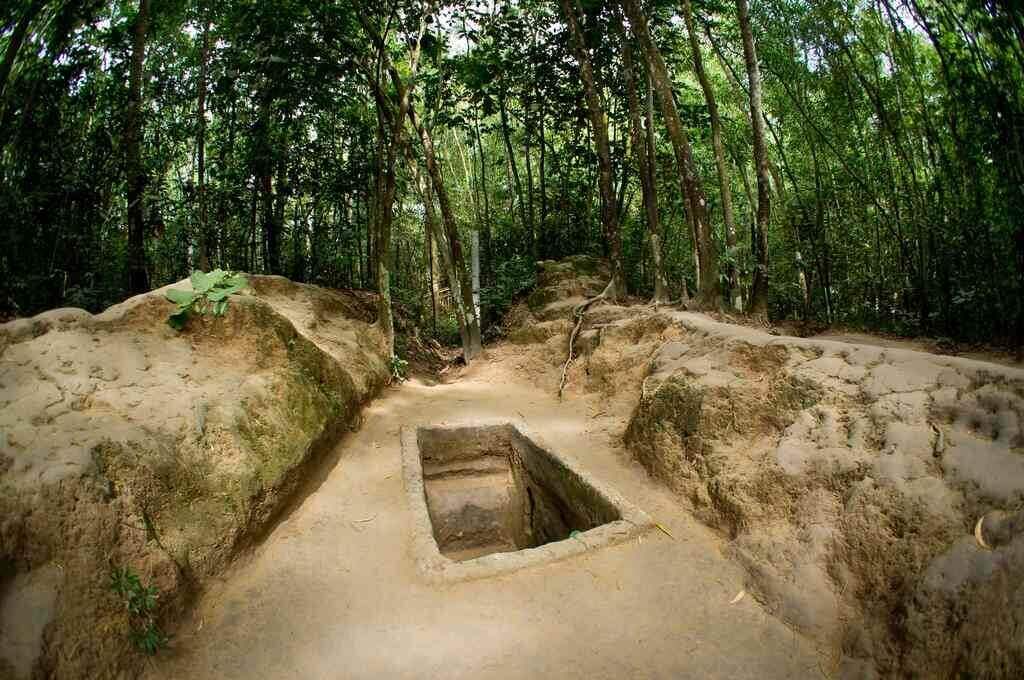
The Cu Chi Tunnels date back to the early 1940s, when Vietnamese villagers began digging them as a means of protection against French colonial forces. During the First Indochina War (1946-1954), the tunnels were expanded and fortified, becoming an important refuge for Viet Minh fighters.
Early Beginnings
- The tunnels were initially dug by hand using simple tools like woven bamboo baskets and hoes.
- They served as a shelter for villagers during the French occupation and later became a strategic military base.
- The network of tunnels was constantly expanded and reinforced throughout the years of conflict.
Viet Minh Resistance
- During the First Indochina War, the Viet Minh used the tunnels to launch guerrilla attacks against the French forces.
- The tunnels provided a safe haven for supplies, hospitals, and communication centers.
- This underground network played a crucial role in the eventual victory of the Viet Minh against the French in 1954.
Escalation During the Vietnam War
As the Vietnam War escalated in the late 1950s and early 1960s, the Cu Chi Tunnels became a central component of the Viet Cong’s guerrilla warfare strategy. The tunnels provided a safe haven for soldiers, supplies, and hospitals, allowing them to launch surprise attacks on American forces.
Construction of Cu Chi Tunnels

The Cu Chi Tunnels are an engineering marvel, constructed entirely by hand using simple tools and equipment. The villagers and guerrillas who dug the tunnels faced immense challenges, working in stifling heat and humidity, with limited supplies and constant threat of discovery.
Digging Techniques
- The tunnels were dug using simple tools like woven bamboo baskets, hoes, and shovels.
- The earth was removed in small increments to avoid surface collapse.
- Ventilation shafts were dug at intervals to provide air circulation and smoke dispersal.
Materials and Techniques
| Material | Purpose |
|---|---|
| Bamboo | Reinforcing tunnel walls and floors |
| Wood | Constructing trapdoors and underground facilities |
| Termite soil | Providing a binding agent for tunnel walls |
- Specialized teams were responsible for digging, fortification, and maintenance of the tunnels.
- Tunnels were designed with multiple entrances and exits for strategic maneuverability.
Challenges Faced
Unordered list:
- Working in cramped and claustrophobic conditions
- Dealing with flooding during the rainy season
- Maintaining secrecy and avoiding detection by enemy forces
- Lack of resources and supplies for sustained construction
Purpose of Cu Chi Tunnels
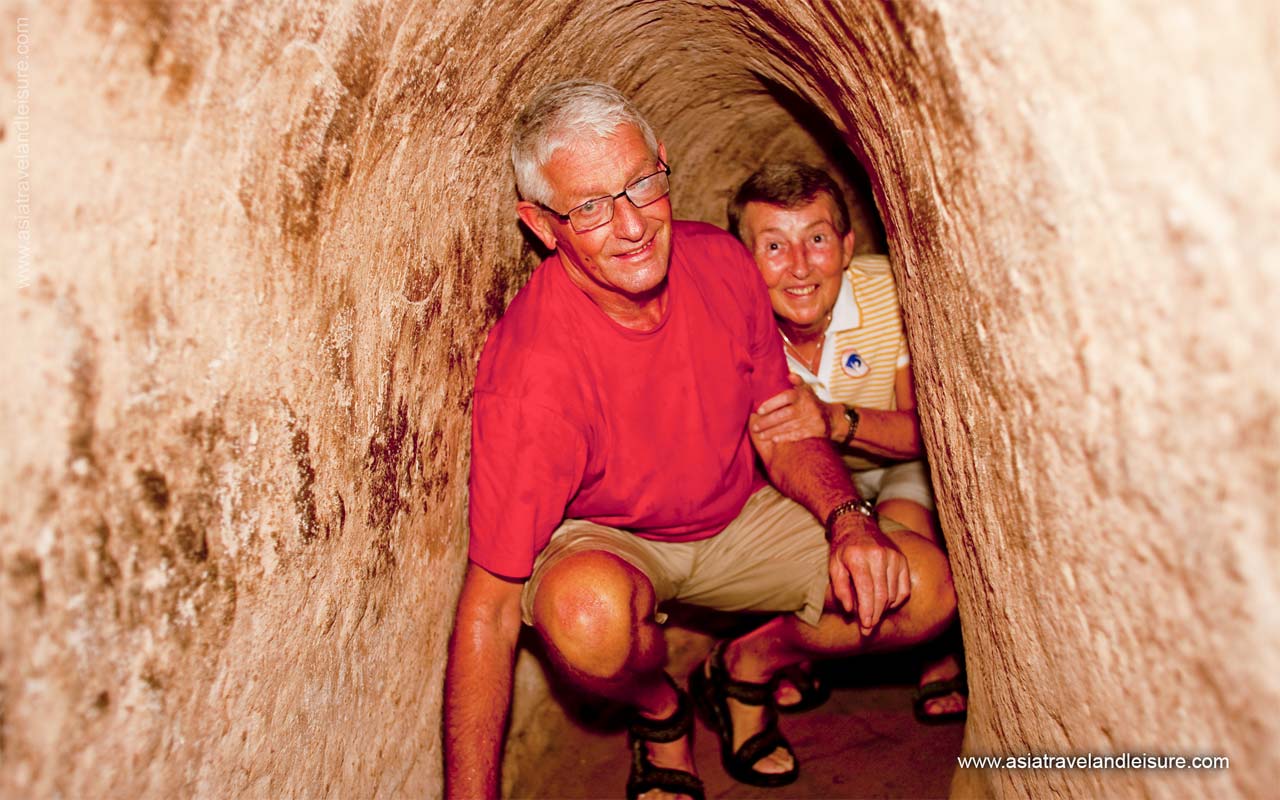
The Cu Chi Tunnels served multiple purposes during the Vietnam War, making them a crucial asset for the Viet Cong guerrillas.
Military Purposes
- Providing a hidden transportation network for troops and supplies
- Facilitating surprise attacks and ambushes against American and South Vietnamese forces
- Serving as underground hospitals, command centers, and living quarters
Civilian Purposes
- Offering shelter and protection for villagers during bombardments
- Enabling the continuation of daily life activities, such as cooking and farming
- Providing a safe haven for families and children during times of conflict
Psychological Warfare
- The tunnels instilled fear and uncertainty in the minds of American soldiers, who faced an unseen enemy.
- The ability to move undetected and launch surprise attacks demoralized enemy forces.
- The tunnels became a symbol of the Viet Cong’s determination and resilience.
Features of Cu Chi Tunnels

The Cu Chi Tunnels were a sophisticated and intricate network, designed to withstand enemy attacks and provide a secure living environment for the Viet Cong.
Layout and Design
- The tunnels were dug at multiple levels, with the deepest level reaching up to 10 meters (33 feet) underground.
- The network consisted of living areas, storage facilities, hospitals, and command centers.
- Ventilation and air filtration systems were ingeniously designed to maintain breathable air.
Camouflage and Concealment
- Tunnel entrances were skillfully camouflaged with termite mounds, trapdoors, and false entrances.
- The tunnels were designed with sharp turns and low ceilings to impede the movement of enemy forces.
- Booby traps and spike pits were strategically placed to deter intruders.
Underground Facilities
- Underground kitchens were equipped with specialized air filtration systems to disperse smoke and cooking odors.
- Underground hospitals treated wounded soldiers and provided basic medical care.
- Ammunition and supply caches were strategically located throughout the tunnel network.
Life in Cu Chi Tunnels
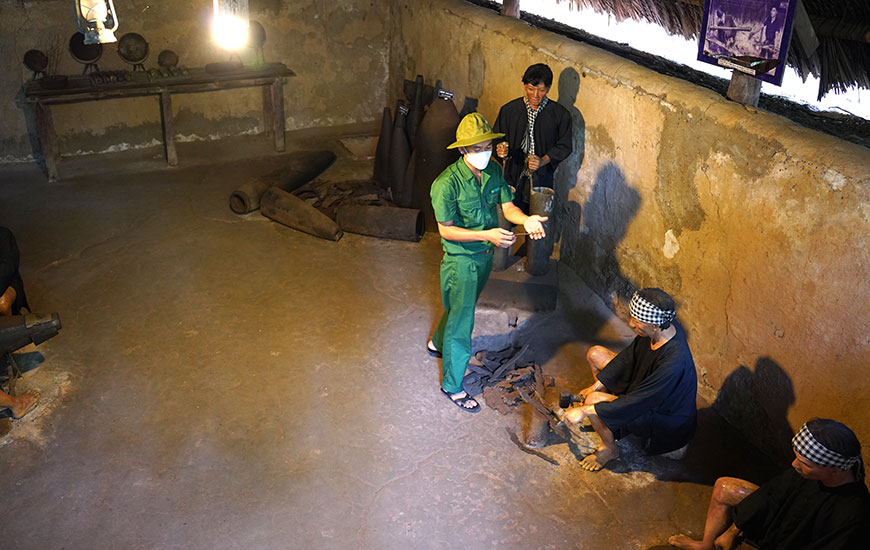
Despite the harsh and confined conditions, the Cu Chi Tunnels were a thriving underground community during the Vietnam War.
Daily Routines
- Strict routines were followed to maintain order and minimize noise and disturbance.
- Cooking and other activities were scheduled to avoid detection by enemy forces.
- Soldiers and civilians took turns resting and performing assigned tasks.
Living Conditions
- Tunnel inhabitants slept in cramped quarters, often sharing space with strangers.
- Sanitation and hygiene were significant challenges in the confined spaces.
- Food and water supplies were limited, and rationing was common.
Psychological Toll
- Living underground for extended periods took a psychological toll on inhabitants.
- Lack of natural light and fresh air contributed to stress and anxiety.
- The constant threat of discovery and enemy attacks created a tense and vigilant atmosphere.
Tourism at Cu Chi Tunnels
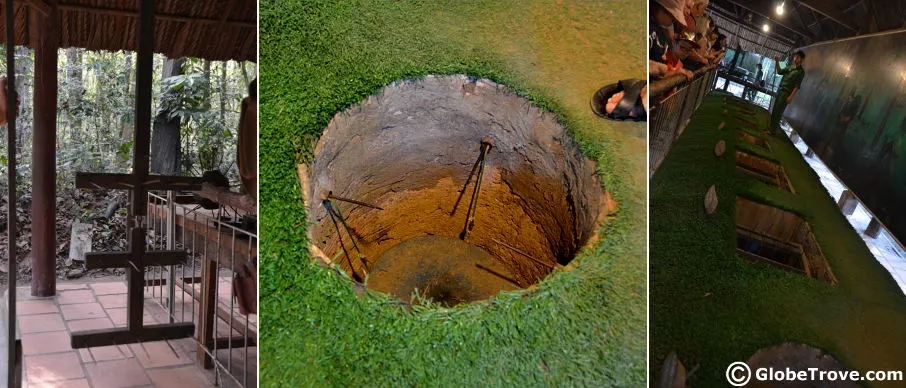
Today, the Cu Chi Tunnels have become a popular tourist destination, offering visitors a glimpse into the ingenuity and resilience of the Vietnamese people during the war.
Guided Tours
- Guided tours are available, led by knowledgeable guides who share stories and historical insights.
- Visitors can crawl through sections of the tunnels to experience the claustrophobic conditions.
- Exhibits and displays showcase the tools, equipment, and artifacts used by the Viet Cong.
Immersive Experiences
- Visitors can participate in simulated scenarios, such as firing weapons or navigating through booby-trapped tunnels.
- Live demonstrations showcase the techniques used for digging and camouflaging tunnel entrances.
- Educational programs and workshops provide opportunities to learn about the history and significance of the Cu Chi Tunnels.
Preservation Efforts
- The Cu Chi Tunnels are a designated UNESCO World Heritage Site, ensuring their preservation for future generations.
- Conservation efforts are ongoing to maintain the integrity of the tunnels and protect them from environmental degradation.
- Educational initiatives aim to raise awareness about the tunnels’ historical significance and the sacrifices made during the war.
Cu Chi Tunnels during the Vietnam War
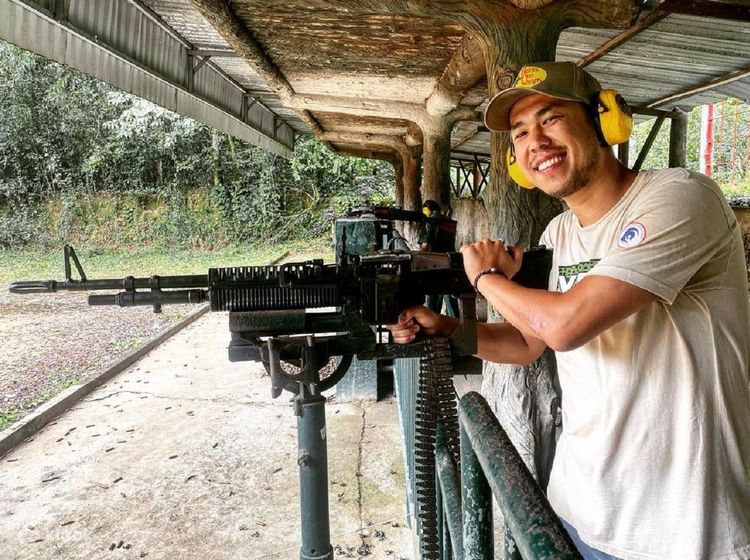
The Cu Chi Tunnels played a pivotal role in the Vietnam War, serving as a strategic base for the Viet Cong guerrillas and a formidable challenge for American and South Vietnamese forces.
Viet Cong Guerrilla Tactics
- The tunnels enabled the Viet Cong to launch surprise attacks and ambushes against enemy forces.
- Guerrilla fighters could move undetected, strike quickly, and disappear back into the tunnels.
- The network of tunnels provided a secure supply line and communication network.
American and South Vietnamese Operations
- American and South Vietnamese forces launched numerous operations to locate and destroy the tunnel networks.
- Tactics included aerial bombardments, chemical weapons, and large-scale ground operations.
- Despite their efforts, the tunnels proved resilient, and the Viet Cong continued to use them effectively.
Battle of Cu Chi
- In 1966-1967, the Battle of Cu Chi was a major confrontation between American forces and the Viet Cong.
- The battle highlighted the challenges faced by American soldiers in fighting an elusive and well-entrenched enemy.
- The Viet Cong’s intimate knowledge of the tunnels and their guerrilla tactics proved effective in resisting the American offensive.
Cu Chi Tunnels today
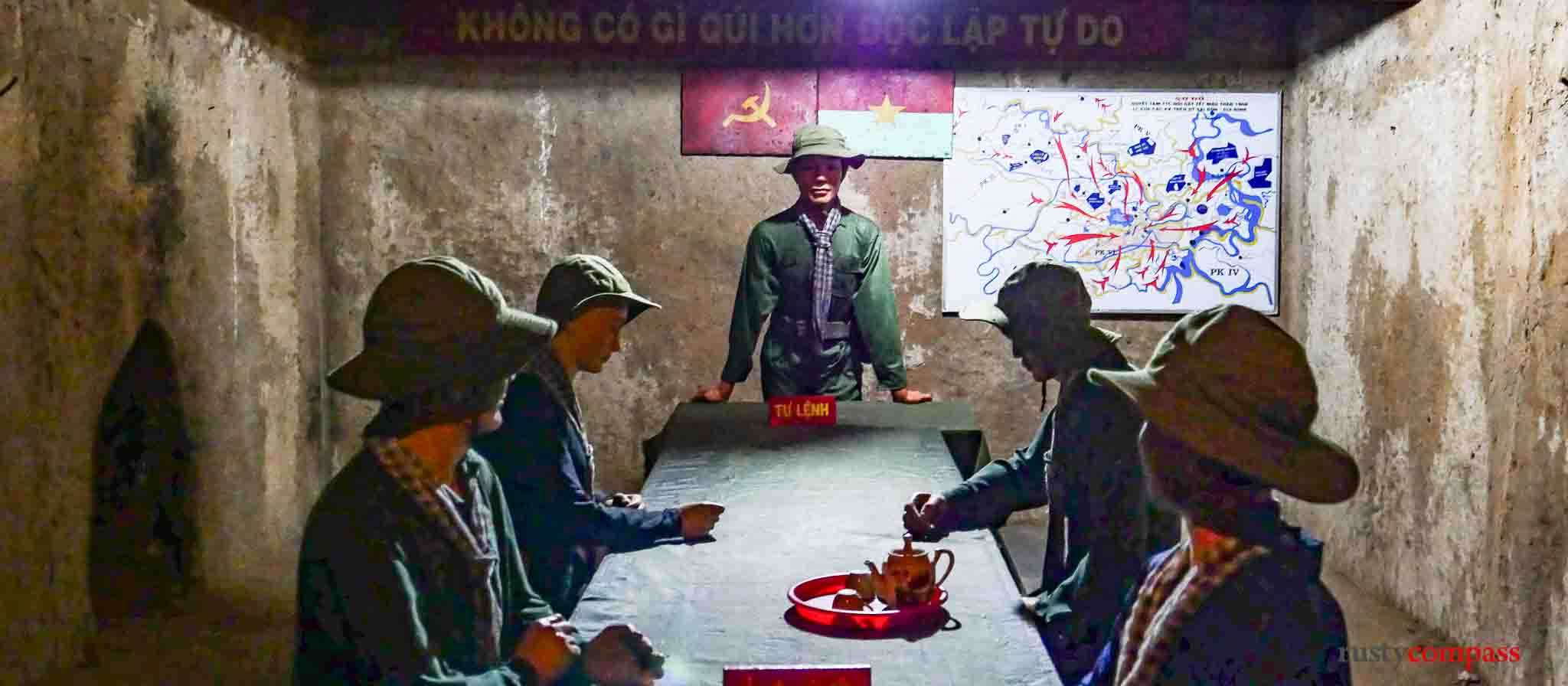
In the aftermath of the Vietnam War, the Cu Chi Tunnels have been preserved as a historical site and a reminder of the resilience and determination of the Vietnamese people.
Memorial and Education
- The Cu Chi Tunnels serve as a memorial to the sacrifices made by the Vietnamese people during the war.
- Educational programs and exhibits provide insights into the history and significance of the tunnels.
- Visitors can learn about the impact of the war on the local population and the enduring legacy of the conflict.
Cultural Heritage
- The Cu Chi Tunnels are an important part of Vietnam’s cultural heritage, representing a symbol of resistance and perseverance.
- Local communities continue to honor and commemorate the bravery of those who fought in the tunnels.
- Traditional ceremonies and events celebrate the resilience of the Vietnamese people in the face of adversity.
Tourism and Economic Development
- Tourism at the Cu Chi Tunnels has contributed to economic development in the region, providing employment opportunities and income for local residents.
- Hotels, restaurants, and other businesses have emerged to cater to the growing number of visitors to the site.
- The tunnels have become a source of pride for the Vietnamese people, showcasing their history and heritage to the world.
Secrets of Cu Chi Tunnels

The Cu Chi Tunnels hold many secrets and stories of courage, ingenuity, and survival from the Vietnam War era.
Ingenious Engineering
- The construction of the tunnels involved innovative engineering techniques, including the use of simple tools and manual labor.
- Viet Cong soldiers demonstrated remarkable skill in digging, reinforcing, and maintaining the tunnel network.
- The intricate design of the tunnels allowed for efficient movement and communication underground.
Camouflage and Deception
- Camouflage played a crucial role in concealing the entrances to the tunnels and confusing enemy forces.
- Trapdoors, false walls, and hidden compartments were used to mislead and deter intruders.
- The ability to blend seamlessly into the surrounding environment gave the Viet Cong a strategic advantage.
Survival Tactics
- Inhabitants of the tunnels developed survival tactics to endure the harsh conditions and constant threat of discovery.
- Strategies included rationing food and water, minimizing noise and light, and maintaining strict discipline.
- The resourcefulness and adaptability of the Viet Cong were key to their survival in the tunnels.
Impact of Cu Chi Tunnels on the War
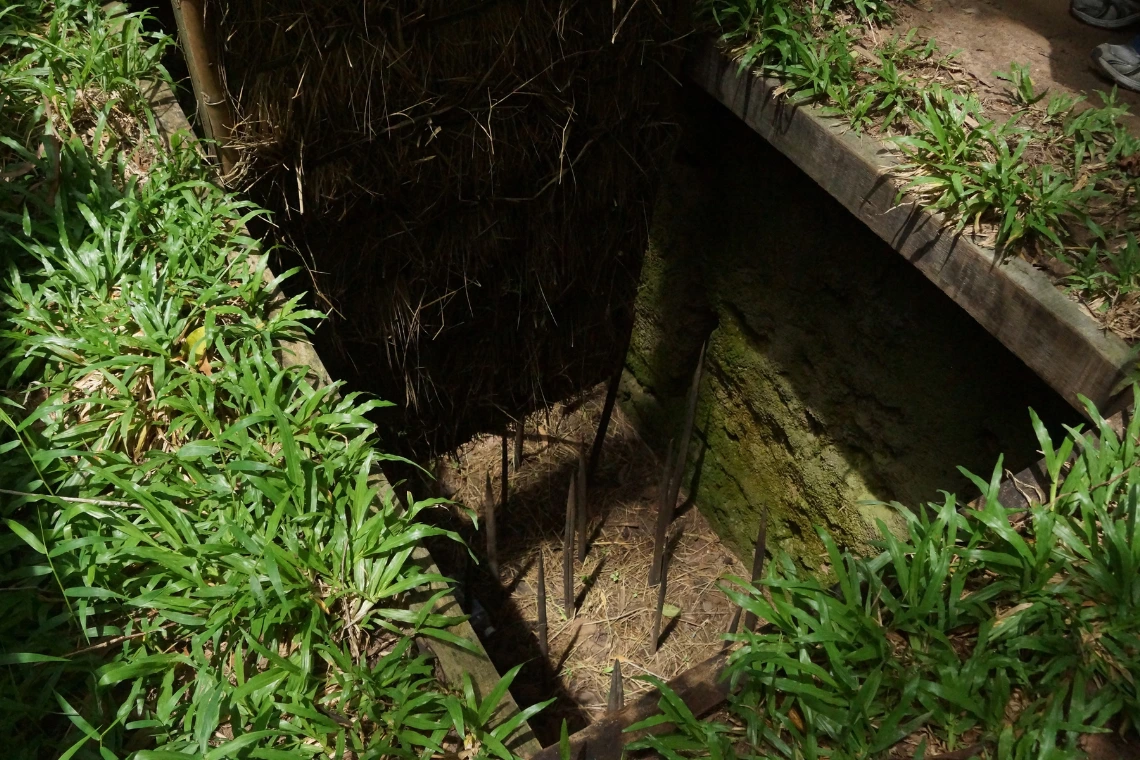
The Cu Chi Tunnels had a significant impact on the outcome of the Vietnam War, influencing military strategies and shaping the course of the conflict.
Military Strategy
- The tunnels forced American and South Vietnamese forces to adapt their tactics and engage in unconventional warfare.
- The guerrilla tactics employed by the Viet Cong in the tunnels posed a formidable challenge to conventional military operations.
- The tunnels became a symbol of resistance and defiance against a technologically superior enemy.
Psychological Warfare
- The psychological impact of the tunnels on American soldiers was profound, instilling fear and uncertainty in their minds.
- The unseen threat posed by the Viet Cong guerrillas in the tunnels created a sense of vulnerability and paranoia.
- The tunnels served as a powerful tool of psychological warfare, undermining the morale and confidence of the enemy.
Legacy and Symbolism
- The legacy of the Cu Chi Tunnels endures as a testament to the courage and determination of the Vietnamese people.
- The tunnels symbolize the resilience and resourcefulness of those who fought against overwhelming odds.
- The lessons learned from the tunnels continue to resonate in military doctrine and historical narratives of the Vietnam War.
Conclusion
In conclusion, the Cu Chi Tunnels stand as a testament to the indomitable spirit of the Vietnamese people during one of the most challenging periods in their history. From their humble beginnings as a means of survival and resistance, the tunnels evolved into a symbol of defiance and ingenuity in the face of adversity. The impact of the tunnels on the Vietnam War was far-reaching, influencing military strategies, shaping the course of the conflict, and leaving a lasting legacy that continues to resonate today. As a historical site and a place of remembrance, the Cu Chi Tunnels serve as a reminder of the sacrifices made by those who fought and lived in their dark, cramped confines. Visiting the tunnels offers a glimpse into the past and a deeper understanding of the human cost of war, while also celebrating the resilience and courage of the Vietnamese people.